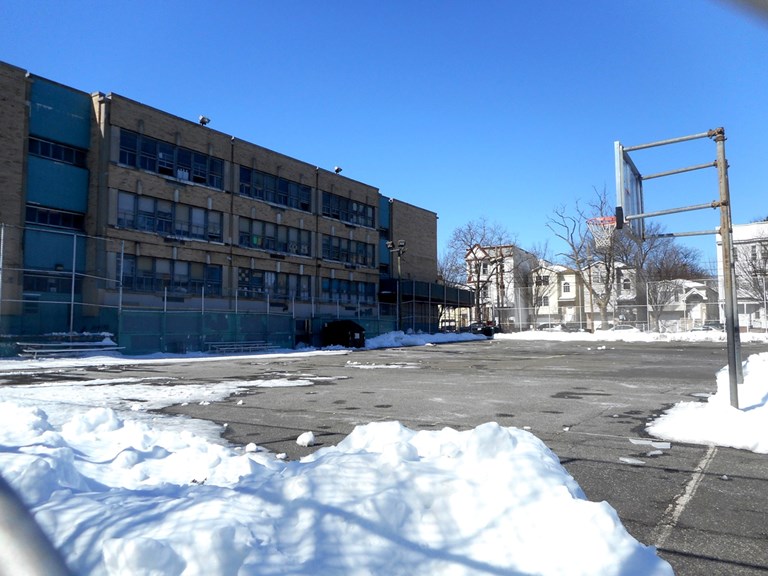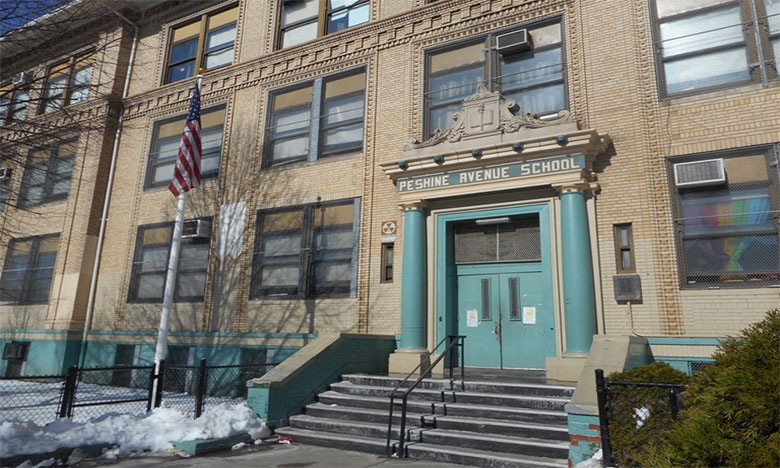Though metal grates protect the windows of the imposing brick building of this pre-K through eighth-grade school, the interior walls are decorated with art and echo with the sounds of chattering children. In class, one small group is working with a teacher while another collaborates over a set of laptop computers. When the bell rings, the students walk in order along the lines painted on both sides of the hallway floor. The teacher leading the way is wearing a onesie, and the children are following suit — it’s pajama day.
The Newark, New Jersey, neighborhood where the Peshine Academy is located is in the top 1 percent. But it’s nothing to celebrate — these few blocks in the city’s southwest rank in the top 1 percent of neighborhoods in the U.S. for single-mother households. It’s also near the top for child poverty rates: 61 percent. A quarter of the students at the school have special education needs, and nearly 90 percent receive free lunches; the racial makeup is 80 percent Black and 20 percent Latino.
A couple of miles down the road is Avon Academy, which used to be Newark’s worst performing school and the second worst in all of New Jersey. Both schools are now around the middle of the pack thanks to the turnaround work of the management company, BRICK, which took over Avon in 2011 and Peshine in 2012.
But this is not a story of an innovative charter school company — that is, a privately managed
organization given freedom from district control to run public schools. Both of BRICK’s schools remain traditional public schools, dealing with teacher unions and district oversight like any other. Instead, BRICK has a bespoke Memorandum of Understanding that gives it limited freedoms “in exchange for results,” says founder and executive director Dominique Lee — a sort of halfway house.
But this fall, BRICK — it stands for “Building Responsible, Intelligent and Creative Kids” — is also opening a charter school. “We will still maintain our work in our traditional public schools, but we will also have a couple of charter schools, so a diverse portfolio,” says Lee. “I don’t follow either side — charter versus traditional public — because I think that is a false dichotomy.” In a city — and indeed a nation — divided by the politics of education reform, BRICK’s mission aims to bridge that gap. BRICK has “made a very deliberate effort to create a certain culture of expectation for student success” in the schools, says 36-year Newark teacher and chair of the Newark Board of Education Antoinette Baskerville-Richardson.
Charter schools can’t be the only solution for struggling school districts, says Lee. He employs a common refrain of those opposed to the contemporary educational reform movement: Charters too often leave behind certain children “because they don’t have an advocate in their lives to take advantage of the [school] choice that is presented before them.” In practice, the “school turnaround agency” starts with a “descriptive” and “unified” curriculum that sets out “from minute to minute” what teachers should be teaching and at what pace.
While some may criticize this straitjacketed approach, Lee is “unapologetic,” noting that “we’re not about creativity right now, we’re about getting teaching and learning to the quality that’s necessary for our children.” The school day has been extended by an hour, and less than 5 percent of the original teaching staff remain. “What we try to do is to bring best practices from charter schools over into the traditional public school space,” says Lee. “Of course, the bureaucracy doesn’t like that a lot of the time,” he says, referring mainly to the administrative hurdles surrounding hiring — another popular refrain, this time of the pro-charter movement. Some of the lessons flow the other way too — district schools are more used to dealing with social and emotional therapy for children facing trauma and extreme special education needs, he says.

Lee’s political agnosticism is refreshing in a city where the debate over educational policy has become toxic. The city’s chronically failing school district has been state-controlled for more than 20 years. More money is spent per student in Newark than in any other school district in the country, yet outcomes remain poor, if slowly improving — only 22 percent of students are proficient in English and 18 percent in math. In 2010, Facebook billionaire Mark Zuckerberg announced a $100 million gift to reform Newark schools on The Oprah Winfrey Show, with then-popular governor Chris Christie and ascendant mayor Cory Booker.
If anything, the windfall inflamed matters further. Most of the money was spent on controversial amendments to teacher contracts, and more than $20 million went to management consultants. Wide-reaching reforms under the so-called One Newark policy from the state-appointed former superintendent were criticized as top-down with little or no community involvement, causing mass protests and widespread anger.

